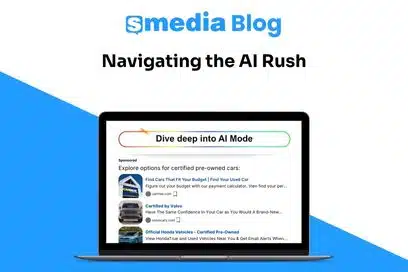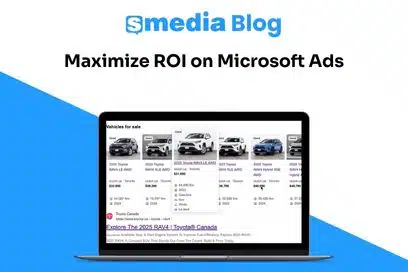Are Leads Leading You On? Read more here, and let’s break it down further below.
Let’s face it—GA4 isn’t exactly plug-and-play. To truly unlock its potential, you either need someone in-house who lives and breathes analytics or a partner who’s transparent, experienced, and ready to roll up their sleeves (yes, that’s where we come in).
Whether you’re tracking organic, paid, or a full-funnel mix, understanding the traffic on your website, where it comes from, and what it does (or doesn’t do) while it’s there is crucial to your business success.
Maintaining your own GA4 as your dealership’s source of truth is not only an Automotive Standards Council recommendation but is also essential for clarity and consistency in your digital data.
The following is a list of the metrics that we recommend you start tracking at your dealership.
1. Key Events
A key event is an event that measures an action that’s particularly important to the success of your business. It’s important to note that a key event can be any action on your website that you’ve decided to measure – key events between GA4 properties will not necessarily be the same thing.
Understanding behaviors specific to your local market, like vehicle model preferences or regional dealership location, can help tailor the events you track for more localized insights. See the highly anticipated Automotive Standards Council Specification Version 1.1 release here to help you understand what events the council recommends using and tracking.
Custom Events: Beyond standard events, ensure you’re tracking custom events that are specific to your business. For example, tracking things like “vehicle comparison,” “test drive request,” or “inventory filter usage” can give deeper insights into customer intent.
Event Parameters: GA4 allows you to set up additional parameters for your events (e.g., car model, dealership location, lead source). This can be useful for deeper segmentation and better reporting.
Cross-Platform & Cross-Channel Tracking: If you’re running campaigns across multiple ad platforms (e.g., Meta, TikTok, Google) and digital properties (like your website), make sure you’re tracking consistent events. This ensures a unified view of performance and helps you compare what’s working across each channel: Here’s how.
2. Sessions
A session is a period of time during which a user interacts with your website or app. An engaged session is a session that meets any of the following criteria:
- Lasts longer than 10 seconds
- Has a key event
- Has 2 or more screen or page views
Monitoring engaged sessions is just as critical as monitoring sessions and key events, especially with the unique shopping behaviors of vehicle buyers. Not every shopper will submit a lead or contact the dealership, but they may still actively engage on your website. Breaking down session sources by region can also help provide insights into the specific channels driving traffic and conversions in different areas.
Engaged Prospect Metric (EPM)
Developed by sMedia, EPM is a more meaningful way to measure real shopper intent. We measure engagement on the Vehicle Details Page and use it to understand the quality of your ads, the quality of the content on your VDP, and to build audiences for your ads. With EPM, dealerships can begin to distinguish true prospects from casual visitors or tire-kickers, which means:
- More efficient ad spend
- Better quality leads
- Smarter retargeting and follow-up
By aligning marketing efforts with actual shopping behavior, dealers can drive more value from every campaign and waste less on people who were never really in the market to begin with.
Session Source/Medium
Consider breaking down your sessions by source and medium (e.g., organic search, paid ads, social media) to understand the effectiveness of each channel in driving traffic and conversions. We like to use the traffic acquisition report in GA4 with the source/medium view to understand the best traffic drivers to your website and dig into which traffic delivers the most events.

3. User Engagement
The User Explorer and Funnel Exploration tools will allow you to further analyze buyers’ behaviors as they move through the purchase cycle. This can highlight local trends like the preference for online research before visiting a dealership or popular vehicles in specific provinces.
User Explorer: Use the User Explorer tool in GA4 to dive deeper into individual user behaviors, especially for tracking the progression of users through their automotive shopping journey. This can help uncover how users interact with your website or app, which pages they visit, and how they convert.
Funnel Exploration: Set up funnel exploration reports to track key stages in the customer journey, such as vehicle research, comparisons, lead form submissions, and completed purchases. This will help identify drop-off points and optimize the user experience: see here.
4. Attribution
Car shoppers often conduct thorough research online before visiting a dealership, making it crucial to understand that no car shopping journey is linear. Attribution models are designed to help assess the impact of your marketing efforts (whether paid search or organic search) on customer conversions.
Cross-device tracking is especially important for North American consumers, who may use a mix of devices during their vehicle research, especially when considering big purchases like cars.
Attribution Modelling: GA4 has different attribution models (like data-driven, last-click, etc.), so consider using a model that aligns with the long, multi-touch automotive buying journey. Attribution can be challenging to accomplish on your own, and without sales data, you’re really only measuring conversion attribution. There are great options for automotive-specific attribution in the market for those dealers who want to explore more granular data.
Cross-Device Tracking: Since many car shoppers research on multiple devices (mobile, desktop, etc.), make sure you’re tracking cross-device activity to get a holistic view of the user’s journey. Get started with attribution in GA4.
5. Audience Segmentation
GA4’s audience builder helps segment users based on behaviors that are specific to your market, such as interest in certain car models or the timing of vehicle purchases. This can allow for more targeted remarketing campaigns that appeal to users’ specific needs and preferences.
Audience Building: Utilize GA4’s audience builder to segment your visitors based on specific behaviors, interests, or events. For example, you can create an audience of users who have viewed a specific vehicle but haven’t completed a lead form, then target them with a remarketing campaign.
Predictive Metrics: GA4 offers predictive audiences (like “likely to purchase” or “likely to churn”). These can be useful for targeting high-intent visitors or optimizing your retargeting efforts. See Segment Builder here.
6. Organic vs Paid Performance
For both organic and paid performance, tracking how well your content answers questions or fulfills the needs of shoppers (e.g., snow tires or fuel-efficient vehicles) is critical. Specific local keywords might drive higher traffic or engagement in certain locations.
As for paid campaigns, tracking metrics like CPC, CTR and CPA is just as crucial to assess the effectiveness of ads targeted to car buyers, especially when dealing with large, competitive markets across North America.
Organic Search Tracking: For organic search, ensure you’re tracking things like landing page performance, bounce rate, and time on page. These can help measure how well your content is answering users’ questions and satisfying their needs during the automotive research phase. Keeping in mind that a high bounce rate isn’t always a negative, it all depends on the objective of that landing page.
Paid Campaign Performance: For paid traffic, it’s crucial to track the full journey—from initial click to final conversion. Focus on key metrics like Cost per Click (CPC), Cost per Acquisition (CPA), and lead-to-sale conversion rates. Be sure to link your Google Ads account to GA4 for seamless data flow and attribution.
7. E-commerce Setup
In the age of digital retailing, shoppers are starting to expect a seamless, retail-like experience when researching or purchasing vehicles online. Enhanced e-commerce tracking is critical to capturing these digital touchpoints, whether you’re selling vehicles directly or generating leads.
For dealers offering online vehicle purchasing or lead generation, Enhanced e-commerce in GA4 lets you track key interactions such as vehicle views, add-to-shortlist actions (functioning like “add-to-cart” for vehicles), form submissions, and purchase intent behaviors like test drive bookings or financing inquiries.
Even if your site doesn’t support true vehicle checkouts, you may already have e-commerce functionality in your parts or accessories store. In that case, GA4’s e-commerce setup should be implemented there, too. That transactional data provides a valuable benchmark for understanding how users engage with digital retail features and where there’s room to improve on the vehicle side. Make sure to configure GA4 to track:
- Product (vehicle or part) impressions and clicks
- Add-to-cart or shortlist behavior
- Check out flows and drop-off points
- Final conversions (purchases or qualified leads)
By treating both vehicle and parts inventory as e-commerce data sources, you can better understand customer intent and optimize your digital retail strategy accordingly. How to setup GA4 e-commerce.
8. Data Quality & Privacy Compliance
Ensuring strong data quality and compliance with privacy regulations is essential, regardless of your region. Automotive dealers must implement accurate data tracking alongside consent management tools to align with evolving privacy standards.
Whether it’s PIPEDA in Canada, GDPR in the EU, or CCPA/CPRA in the U.S., these regulations share common principles such as transparency, user consent, and data minimization. Dealership websites should be equipped to manage user preferences effectively, ensuring that all analytics and marketing tags respect regional privacy laws and user choices.
There are 3rd party services or plugins you can add to your website to help with compliance, but it’s important to note that opt-in compliance banners at their most stringent, can reduce your ability to track site metrics.
Did you know that GA4 does not log or store IP addresses?
9. Conversion Tracking: Turning Key Events into Business Insights
In GA4, conversions are simply key events that you’ve marked as valuable to your business. For automotive dealerships, these aren’t just digital clicks—they’re real signals of buyer intent that can lead to sales, service appointments, or showroom visits.
Dealers should track and prioritize actions such as:
- Form Submissions – Online vehicle inquiries and lead forms
- Phone Calls – Click-to-call actions from mobile or desktop
- Test Drive Requests / Appointments – Indicators of high buying intent
- Vehicle Detail Page (VDP) Views – Deeper engagement worth remarketing to
- Offline Visits – While GA4 doesn’t track these directly, you can estimate foot traffic using location data from Google Ads and Google Business Profile
Pro Tip: Additionally, don’t forget about goal completions like test drive requests, vehicle inquiries, or appointment bookings. These are high-value actions that directly impact your bottom line.
By properly setting up and tracking these key events as conversions in GA4, you go beyond just measuring website traffic—you capture buyer intent, which helps you optimize marketing strategies and ultimately drive more foot traffic to your dealership.
What many dealerships don’t realize is that you can import these GA4 conversions directly into Google Ads. This allows you to optimize ad campaigns for real business outcomes like form submissions or VDP engagement instead of just clicks or impressions.
As GA4 and Google Ads become more seamlessly integrated, this strategy offers a low-lift, high-impact way to improve ROI and gain deeper insights into what’s truly driving your campaign performance: here’s how.
To fully optimize your GA4 and capture the most valuable insights for your dealership, it’s crucial to take ownership of your data. Don’t rely solely on your vendors to tell you what’s happening with your digital traffic. Select a source of truth and maintain it or get help to maintain it, ensure that your GA4 reflects changes to your website and the 3rd party tools you use – do not let your digital data be an afterthought. If navigating GA4’s complexities feels daunting or you’re unsure if you’re tracking the right data, we’re here to help!
Let’s work together to streamline your analytics and ensure you’re accurately capturing the data that matters most to you and your business. Contact us today to take the guesswork out of GA4 to start turning your data into actionable insights that drive results.
Want More Insights Like This?
Get our monthly newsletter packed with proven strategies, fresh trends (just the good stuff) to drive traffic, leads, and revenue right to your inbox.
👉 Sign Up Now





